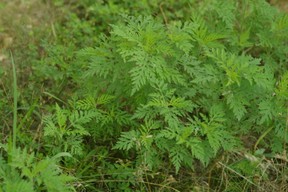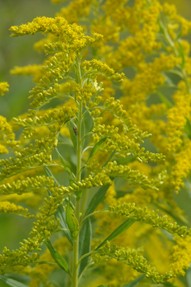Goldenrod and ragweed bloom around the same time in the fall and often grow together. Goldenrod's flowers are deep yellow, but ragweed's flowers are tiny, pale green, and blend it with its leaves. When ragweed releases its pollen, people mistakenly blame goldenrod because it's so visible.
But goldenrod's pollen is heavy and sticky and spread only by insects. Unless you put your nose right into a goldenrod plant and sniff, you shouldn't be affected by its pollen. On the other hand, ragweed's pollen is lightweight and spread by the wind.
Goldenrod is the state flower of both Kentucky and Nebraska.
Goldenrod is the state wildflower for South Carolina and Sweet Goldenrod is the state herb of Delaware.
Goldenrod is also the name of a color: defined as "a strong to vivid yellow."
I took the photographs of goldenrod and ragweed for this article. ~~~ Burntchestnut


 Goldenrod plants needs full to partial sun and soil that drains well. Depending on the species, they bloom from mid to late summer or until it frosts (in cold climates).
Goldenrod plants needs full to partial sun and soil that drains well. Depending on the species, they bloom from mid to late summer or until it frosts (in cold climates).



 Ragweed blooms around the same time and often in the same area as goldenrod. Ragweed
Ragweed blooms around the same time and often in the same area as goldenrod. Ragweed The goldenrod plant grows up to six feet tall with leaves two to five inches long, and clusters of small, bright yellow flowers on top.
The goldenrod plant grows up to six feet tall with leaves two to five inches long, and clusters of small, bright yellow flowers on top.

 The Native Americans used goldenrod as a tea for sore throats and fatigue.
The Native Americans used goldenrod as a tea for sore throats and fatigue.

 I Loved to Read in Grade School (in the 1960s)on 09/29/2018
I Loved to Read in Grade School (in the 1960s)on 09/29/2018
 Halloween Memories from the 1960son 09/17/2018
Halloween Memories from the 1960son 09/17/2018
 What on Earth is Earthing?on 06/03/2015
What on Earth is Earthing?on 06/03/2015
 Worm Manure (Castings) Is The Best Organic Fertilizeron 05/25/2015
Worm Manure (Castings) Is The Best Organic Fertilizeron 05/25/2015



Comments
So far, I haven't come across any except that quail (a bird) likes to hide their young under the leaves. Actually people who hunt quail often plant ragweed for that reason. I guess it's a good weed for other wildlife to hide under, too.
AngelaJohnson, Thank you for the practical information and product line. What beneficial uses do you find for ragweed?